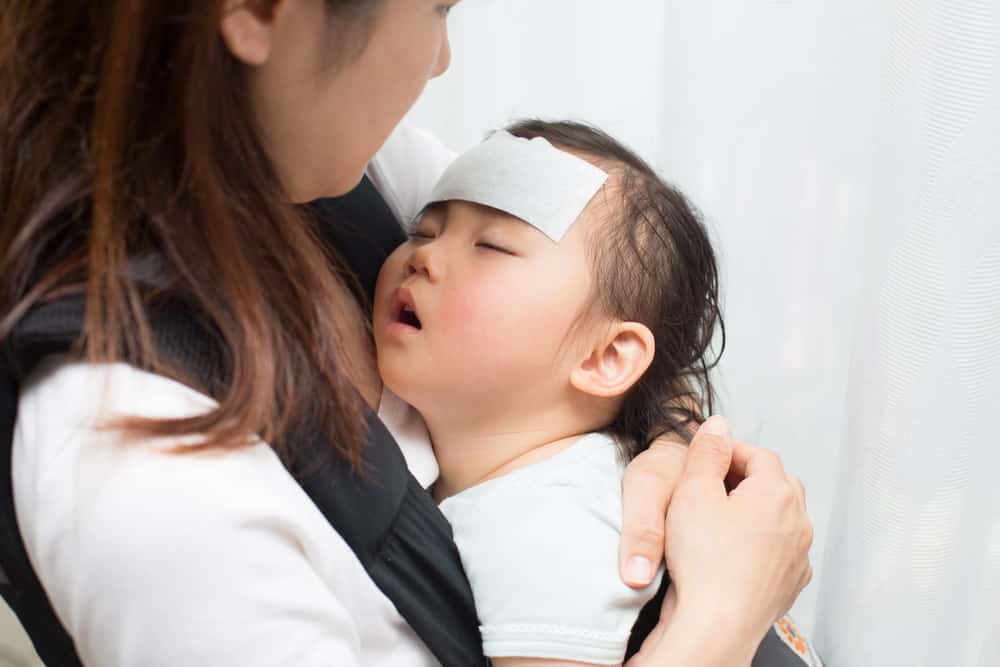It is never easy for a parent to comfort a sick child. You want them to be content, healthy, and ready to play. When your little one has a fever, it can be especially difficult because they are too young to express how they feel or what they need to be comfortable. Therefore, it is your responsibility to calm them down and bring down baby fever so they can feel better as soon as possible.
In this case, knowing what constitutes a fever in a baby and the best course of action to take is your best defense. Continue reading for expert advice on how to bring down baby fever and when to seek medical attention.
Key Points of What to Do When Your Baby Has a Fever
- The moment you feel your baby is warmer than normal take their temperature with an infant-appropriate thermometer.
- Pay close attention to their behavior as behavior is a closer indication of more serious illness.
- Seek medical attention immediately if their temperature is over 104 degrees F.
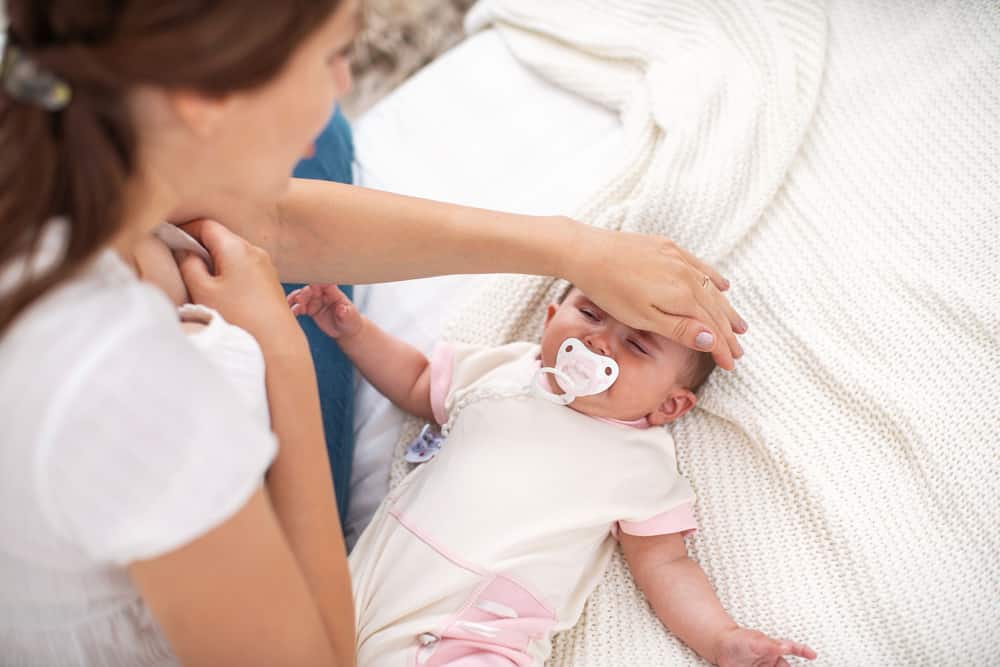
©Alexander_Safonov/Shutterstock.com
What Temperature Is Considered a Fever in Babies?
A baby's normal temperature is 97 to 100.4 degrees Fahrenheit, according to the American Academy of Pediatrics (AAP). Many people do not understand what temperature constitutes a fever in a baby and, as a result, do not always manage the specific situation properly.
If your baby has a fever, he or she has
- A temporal artery, ear, or rectal temperature of 100.4 Fahrenheit (38 Celsius) or higher
- An oral temperature of 100 degrees Fahrenheit (37.8 degrees Celsius) or higher
- An armpit temperature of 99 degrees Fahrenheit (37.2 degrees Celsius) or higher
If you have any doubts about a temperature reading, use a different method to confirm the results.
What Causes High Fever in Babies?
It's important to remember that fever is not a disease or illness in and of itself, but rather a sign that something unusual is going on in your baby's body. The appearance and behavior of your baby are more important than the temperature.
A fever is usually an indication that your child's body is fighting an infection. It is the body's natural defense mechanism against infections. The high body temperature makes bacteria and viruses that cause infections more difficult to survive.

©wear it out/Shutterstock.com
Overheating
The fever is usually mild. This can happen during heat waves or when your baby is overdressed. After moving to a cooler location, the temperature returns to normal in a few hours. Rest and extra fluids help to reduce fever quickly. If their temperature does not return to normal in a few hours, something else might be causing their fever. Always consult with your pediatrician if something feels wrong or if you believe their fever is caused by something other than overheating.
Infections Caused by Viruses
The most common cause is a viral infection, such as a cold or flu. For the first 24 hours, fever may be the only symptom. The onset of viral symptoms (loose stools, cough, runny nose) is frequently delayed. Roseola is a typical example that represents this; For three to five days, fever may be the only symptom, followed by a rash thereafter.
Vaccine Fever
Most vaccines cause fever within 12 hours. It lasts 2-3 days. This is perfectly normal and harmless. It indicates that the vaccine is effective. If your child's vaccine fever lasts longer than 7 days, redness around the injection site grows to over 2 inches, or if your child doesn't improve call your healthcare provider.
Infections Caused by Bacteria
When the immune system detects bacteria in the body, the brain sends a signal to raise the core temperature. When bacteria release toxins into the bloodstream, a fever develops. Bacterial infections can be a serious condition. While a fever does not always indicate a bacterial infection if your baby's temperature climbs over 102 degrees F it might mean they're fighting some form of bacteria.
Infant Fever
Fever during the first three months of life can be dangerous. Infants with this type of fever must be seen by a pediatrician as soon as possible. Sepsis could be causing the fever (a bloodstream infection). Bacterial infections in this age group can progress rapidly. They require immediate medical attention.
Meningitis
This is an infection of the membrane that covers the spinal cord and brain with bacteria. The primary symptoms are stiffness in the neck, headache, and confusion. Younger children are drowsy or irritable and cannot be consoled. Brain damage may occur if not treated as soon as possible.
Sometimes the source of the fever cannot be determined. If your doctor is unable to pinpoint the cause of your baby's fever after extensive testing, the diagnosis may be a fever of unknown origin.
Does Teething Cause a Fever?
No. According to research, “getting teeth,” or teething does not cause fevers. Healthline.com says no evidence suggests teething causes a baby to have a fever. The site says, “If your baby has a fever at the same time as they are teething, another, unrelated illness is likely the cause,” in which case, you may want to consult your pediatrician.
Other myths about Infantile Fevers
There are a handful of myths floating around about infantile fevers, thankfully, the Cleveland Clinic has incredible information on the truth of these myths.
- Myth: Higher temperature means a more serious illness.
- A higher temperature does not always mean a more serious illness. A child's immune system fights all illnesses with full force so it's important to pay attention to how your child is acting.
- Myth: You have to use a rectal thermometer for an accurate reading.
- You don't need to use a rectal thermometer for an accurate reading. Armpits and oral temperature readings will provide a similar degree of accuracy.
- Myth: The only normal temperature is 98.6°F
- Infants' temperatures will fluctuate throughout the day and only a temperature over 100.4 degrees F constitutes a fever.
Signs and Symptoms of Fever
A fever or high temperature may develop gradually over a few days, or it may develop rapidly. It may also fluctuate throughout the day. These things are usually unrelated to the illness that is causing the fever.
A high temperature may make your child feel uneasy. When your child's temperature rises, they may experience chills or shivers, and when it falls, they may sweat. If your child is losing a lot of fluid due to the fever and not drinking enough, he or she may become mildly dehydrated.
Febrile Seizures
When they have a fever, about 5% of children aged 6 months to 6 years have seizures or convulsions (called febrile seizures). These seizures are rarely dangerous and are caused by a virus and a change in temperature in a vulnerable child. Protect children from injuring themselves during a seizure by keeping them away from nearby objects and ensuring that they are breathing freely. These seizures usually stop on their own within a minute. Let your child's doctor know about the seizure. If the seizures continue, go to the hospital.
Most fevers and illnesses that cause them are only temporary. A fever, on the other hand, can last much longer, especially if it is caused by an underlying illness or chronic disease.
How to Take Your Baby's Temperature
As parents gain experience, they can often tell if their baby is warm simply by feeling them. Of course, babies get hot and sweaty after being in a hot room or being overdressed. However, the majority of babies who feel warm but do not have a fever have a normal digital temperature.
A digital thermometer is an absolute necessity in your baby's first aid kit. A plastic, flexible probe with a temperature sensor at the tip and an easy-to-read digital display on the other end is typical of digital thermometers.
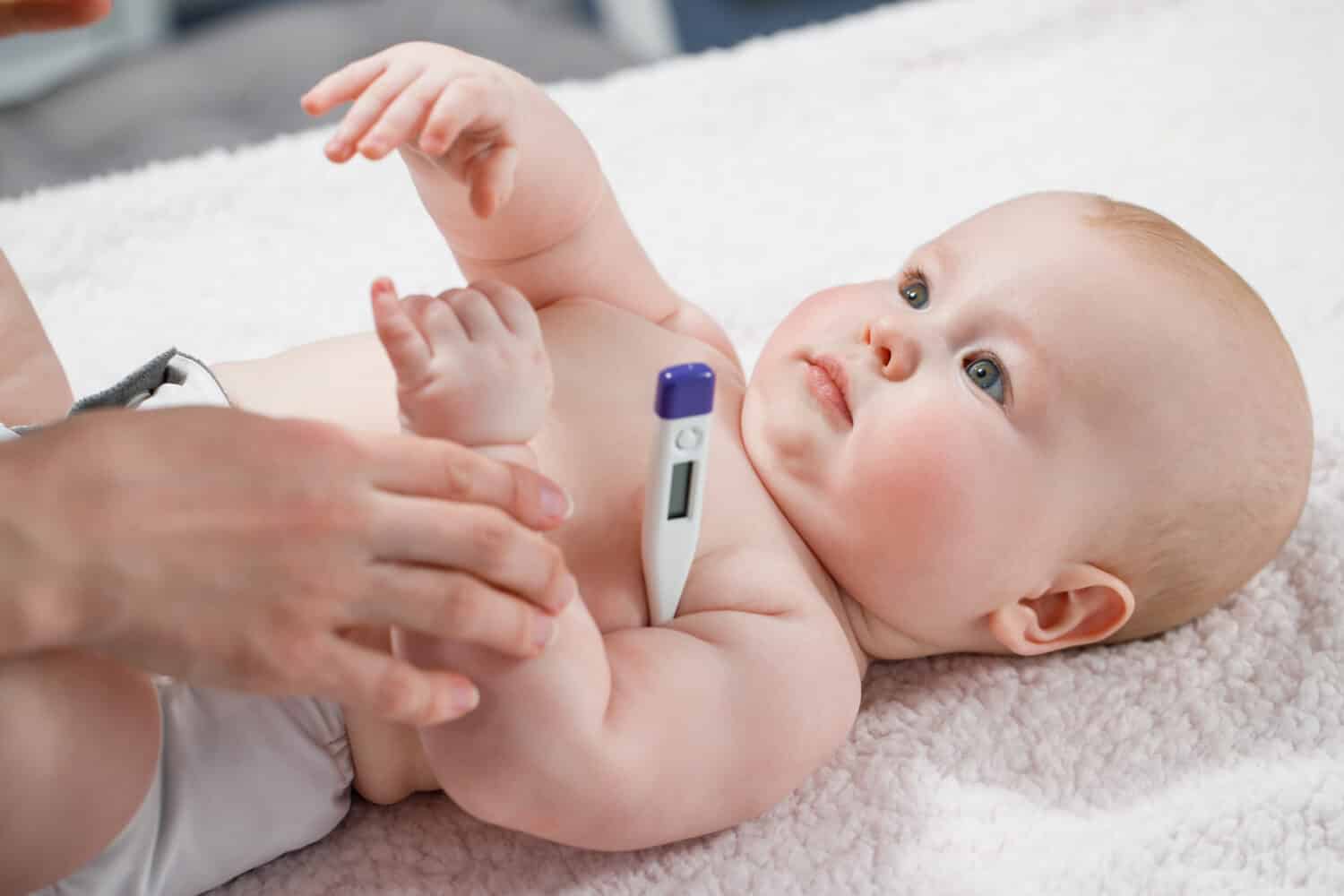
©Goncharov_Artem/Shutterstock.com
- For babies under 3 months old: When taking a rectal temperature, use a digital thermometer to get the most accurate reading. If your infant is under 3 months old and has a temperature of 100.4 degrees Fahrenheit (38 degrees Celsius) or higher, call your doctor.
- A digital rectal thermometer is still the best option for babies aged 3 to 6 months. A temporal artery thermometer (also known as a forehead thermometer) can also be used.
- A digital thermometer can be used to take a rectal temperature in children aged 6 months to 4 years. A tympanic (ear) thermometer or a digital thermometer can also be used to take an axillary (armpit) temperature, but they are less accurate.
How to Bring Down Baby Fever
Here are some things you can do if you wake up in the middle of the night wondering how to bring down a baby's fever. You can certainly talk to your pediatrician about using baby fever medicine but don't dismiss home remedies for baby fever as effective ways to lower a baby's temperature.
1. Give Your Baby a Fever Reducer
Before giving Tylenol to a baby under the age of 6 months, consult your doctor. Your doctor will most likely want to examine your child in person to determine the cause of their illness. For example, if the baby has an ear infection, antibiotics will be required. Your pediatrician will also want to know how much your baby weighs at the time so that they can prescribe the appropriate dose of a fever reducer.
You can give an infant fever reducer without consulting your doctor if your baby is older than 6 months. You should never give aspirin to a child unless specifically instructed to do so by your baby's doctor. Reye's syndrome, a rare but potentially fatal condition, has been linked to aspirin use in children with viral infections.
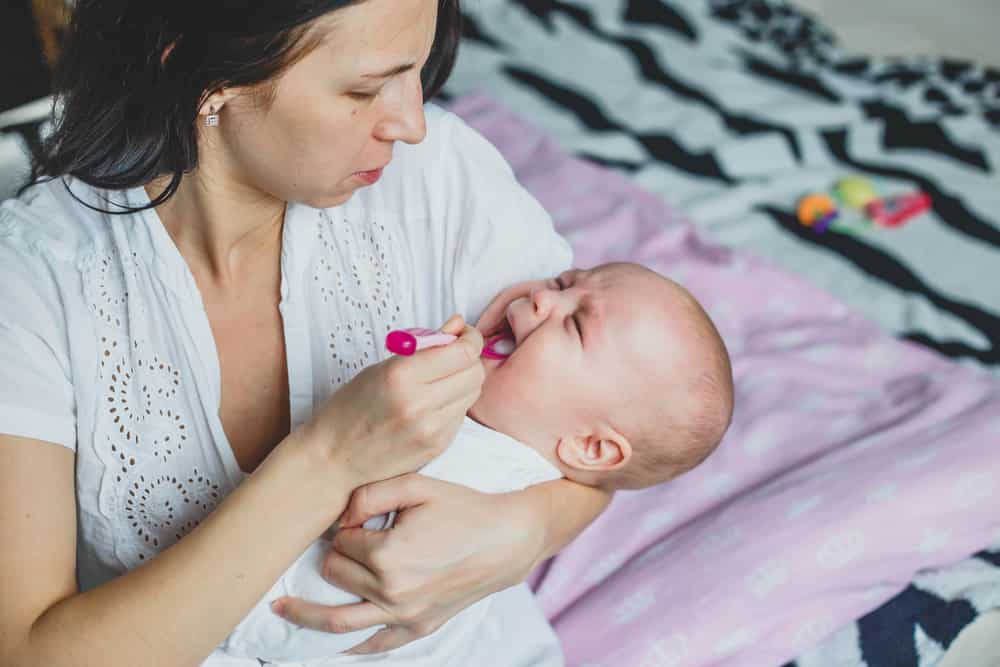
©Olga Alper/Shutterstock.com
2. Use a Fever Reducer Only When Necessary
Not all fevers require treatment. According to the AAP, fever relievers should only be used if the fever is causing discomfort and is higher than 102 or 103 degrees F.
If you do decide to use one, give it just before bedtime to help you sleep better.
Remember that fever reducers only bring the temperature down by 2-3 degrees. If your baby has a high fever, fever reducers will not eliminate the fever, but they should reduce it enough to make your little one more comfortable.
3. Keep Your Baby Hydrated
A fever can cause your baby to quickly lose fluids and become dehydrated. This can lead to serious complications and symptoms worsening. To avoid this, provide fluids as needed to keep them hydrated.
It is best to offer water, clear soups, broth, popsicles, yogurt, or juices to them. If there are signs of dehydration, an oral rehydration solution such as Pedialyte can be used. Breastfeed your baby more frequently if you are breastfeeding. Breastmilk also contains antibodies that can help your little one fight infection, and the skin-to-skin contact can be soothing to them.
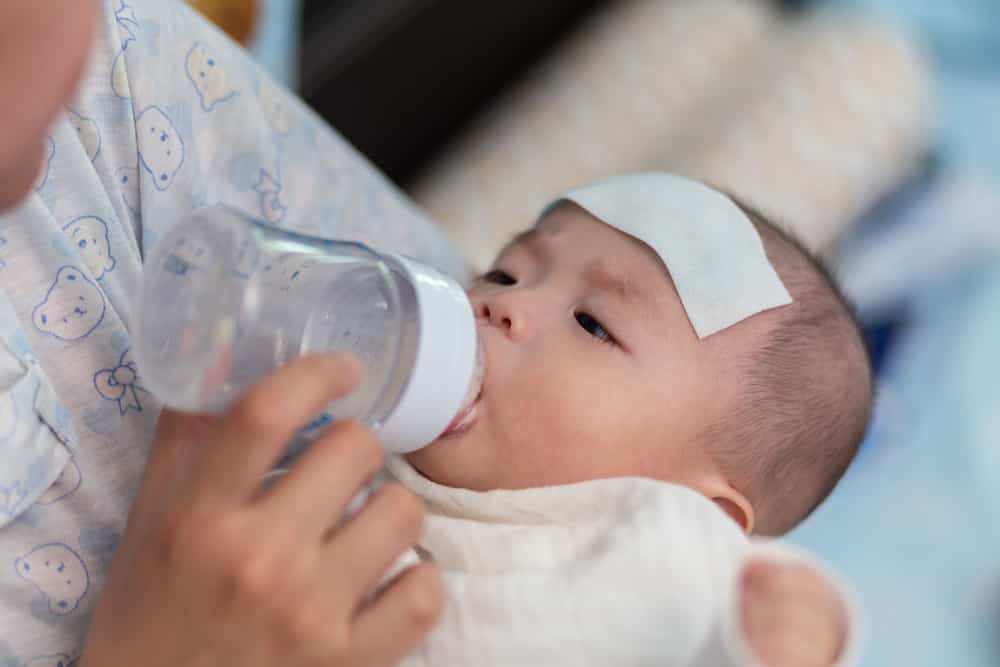
©Alen thien/Shutterstock.com
4. Keep Their Clothing Light
Remove excess clothing to allow your child to lose heat more easily through the skin. Because infants can't regulate their temperature well, cooling them down with multiple layers is more difficult. Always dress them appropriately to your local climate and consult your doctor if you have any questions.
5. Allow the Baby Plenty of Rest
Give your baby ample time and room to sleep quietly. Reduce the amount of lighting in the baby's room and use heavy curtains or blinds to block out noise and light. When the baby has a fever, avoid taking him or her outside. Rest is essential because it allows the body to heal and repair itself naturally.
When to Seek Medical Assistance
Fever on its own isn't necessarily dangerous, but when combined with other symptoms, you should consult your doctor or go to the emergency room. Here are some symptoms to look out for:
- Has a fever of more than 104 degrees F at any age
- Sore throat or severe ear pain
- More drowsy, clingy, irritable, listless, and uninterested in playing, even after the fever has subsided
- There are fewer wet diapers than usual, no tears, and a dry mouth.
- Diarrhea, persistent vomiting, rash, stiff neck, and an apparent headache
- Has a condition that affects the immune system, such as cancer, or is taking steroid medications
- Fever lasting more than 72 hours, or three days, in children aged 2 and up
- Has experienced a seizure
- Has a temperature of more than 100.4 degrees F and is under the age of 3 months
- Fever lasting more than 24 hours in a child under the age of 2
A fever can be confusing, so don't be afraid to call your doctor if you have any questions. When it comes to your baby's health, it's always better to be on the safe side.
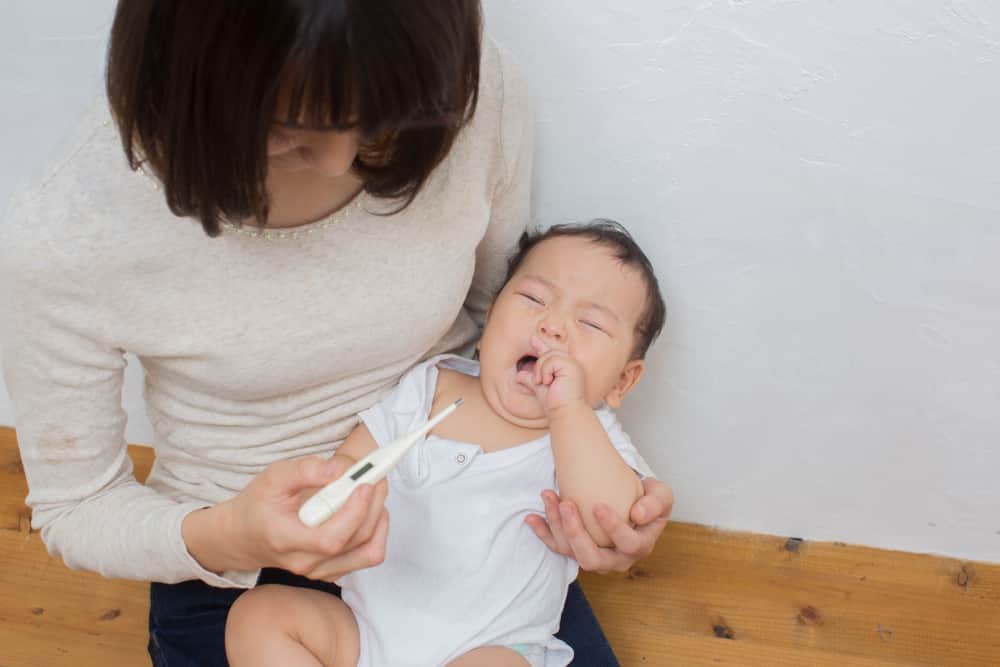
©ucchie79/Shutterstock.com
Conclusion
Ultimately, bringing down baby fever is about keeping your little one comfortable and preventing their temperature from rising too high. You are the expert on everything to do with your baby, so trust your instincts.
If your baby is very sick and has a high fever, always consult with your pediatrician or take them to the doctor. Otherwise, stay at home and lavish extra care and attention on your baby!
The image featured at the top of this post is ©ucchie79/Shutterstock.com.
